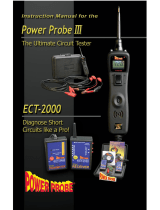
1. Safety Precautions and Warnings
To prevent personal injury or damage to vehicles and/or the test
tool, read this instruction manual first and observe the following
safety precautions at a minimum whenever working on a vehicle:
Always perform automotive testing in a safe environment.
Wear safety eye protection that meets ANSI standards.
Keep clothing, hair, hands, tools, test equipment, etc. away from
all moving or hot engine parts.
Operate the vehicle in a well ventilated work area: Exhaust gases
are poisonous.
Put blocks in front of the drive wheels and never leave the vehicle
unattended while running tests.
Use extreme caution when working around the ignition coil,
distributor cap, ignition wires and spark plugs. These
components create hazardous voltages when the engine is
running.
Put the transmission in PARK (for automatic transmission) or
NEUTRAL (for manual transmission) and make sure the parking
brake is engaged.
Keep a fire extinguisher suitable for gasoline/chemical/ electrical
fires nearby.
Don‟t connect or disconnect any test equipment while the
ignition is on or the engine is running.
Keep the tool dry, clean, free from oil/water or grease. Use a mild
detergent on a clean cloth to clean the outside of the test tool,
when necessary.
When the power switch in the tool is depressed battery
current/voltage is conducted directly to the tip which may cause
sparks when contacting ground or certain circuits. Therefore the
tool should NOT be used around flammables such as gasoline or
its vapors. The spark of an energized tool could ignite these
vapors. Use the same caution as you would when using an arc
welder.























